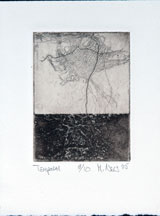 Trajectories that meet at a single point are called a convergence. Lines become a single point of intersection, and these places are rare. Rare in life, and I think intriguing in art. This image is a detail of an etching I did several years ago. The piece is called “Temporal”. The idea to me was just the wonder in the slowness of time. As things look random, time is what gives us a chance to view the quiet emergence of so much that is important: the blossoming of fruit, the maturing of character, the perfect development of every longed for thing. And in this waiting there can be great mercy as a trajectory moves toward fulfillment.
Trajectories that meet at a single point are called a convergence. Lines become a single point of intersection, and these places are rare. Rare in life, and I think intriguing in art. This image is a detail of an etching I did several years ago. The piece is called “Temporal”. The idea to me was just the wonder in the slowness of time. As things look random, time is what gives us a chance to view the quiet emergence of so much that is important: the blossoming of fruit, the maturing of character, the perfect development of every longed for thing. And in this waiting there can be great mercy as a trajectory moves toward fulfillment.
Right now in the evening sky there is an unusual convergence happening. You can see it at dusk above the western horizon. The planets Venus and Jupiter have been moving in their singular orbits closer and closer toward a meeting as seen from our vantage point on earth. Tonight, June 30th they will be so near as to appear as one large star. The constellations (that is the star clusters that have been identified by several ancient cultures) are a pictorial back drop behind what happens as our solar system keeps moving like a swiss watch. This convergence of two planets in line with our own is happening in front of the constellation Leo. Maybe that means something. Maybe it doesn’t. But, thinking like an artist, I’m paying attention. Something’s happening here.
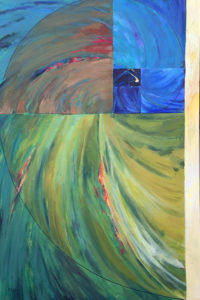 What I am posting today image-wise is a little embarrassing. I did this in 2002. It is a rather large piece: 3’x2′, laid down originally with acrylic. I was ambitiously hoping to put into imagery what I see happening in this collection of Psalms, but critiquing my own attempt, this is brash looking, really uninteresting visually, too direct. For these reasons and others this piece sat hidden behind much else for the last 13 years.
What I am posting today image-wise is a little embarrassing. I did this in 2002. It is a rather large piece: 3’x2′, laid down originally with acrylic. I was ambitiously hoping to put into imagery what I see happening in this collection of Psalms, but critiquing my own attempt, this is brash looking, really uninteresting visually, too direct. For these reasons and others this piece sat hidden behind much else for the last 13 years.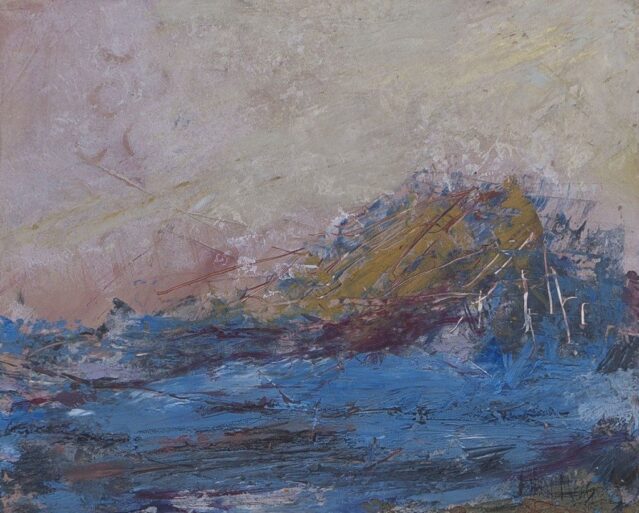

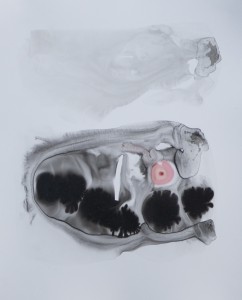 This image, which is the last in a 4 part series (still hanging at the Reece Museum on ETSU’s campus) is a visual glimpse. There are two parts to it’s form: a wispy cloud-like from in the upper horizon, and a more grounded darker mass. Both these forms show movement in one direction, and they are moving together that way. The bottom form is enclosed, and seems to be a holding place that is dynamic and not completely shut. This is a picture of fearful grace. Fear must come first for grace to even be a topic of concern. Both these ideas are glimpsed here. I could say more. I would be interested in how this image affects viewers who may well see more, or who may see what I did not intend as this gets viewed and judged and passed over as part of the public record. For me, as I made this, and as I still muse on what dried in front of me with the inks settling: this is a glimpse of hope that still hangs in time.
This image, which is the last in a 4 part series (still hanging at the Reece Museum on ETSU’s campus) is a visual glimpse. There are two parts to it’s form: a wispy cloud-like from in the upper horizon, and a more grounded darker mass. Both these forms show movement in one direction, and they are moving together that way. The bottom form is enclosed, and seems to be a holding place that is dynamic and not completely shut. This is a picture of fearful grace. Fear must come first for grace to even be a topic of concern. Both these ideas are glimpsed here. I could say more. I would be interested in how this image affects viewers who may well see more, or who may see what I did not intend as this gets viewed and judged and passed over as part of the public record. For me, as I made this, and as I still muse on what dried in front of me with the inks settling: this is a glimpse of hope that still hangs in time.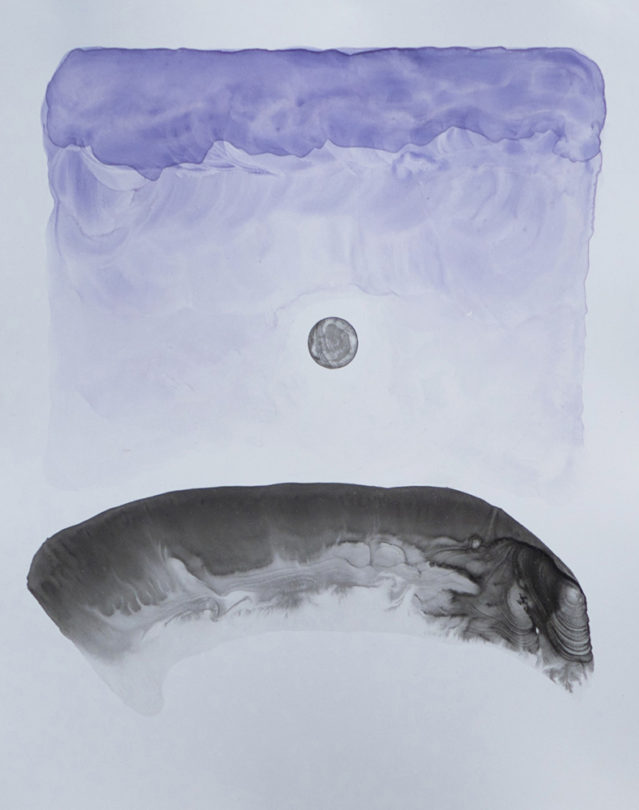
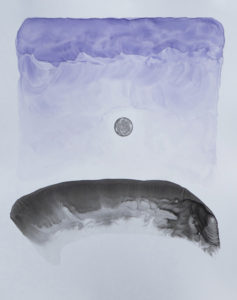
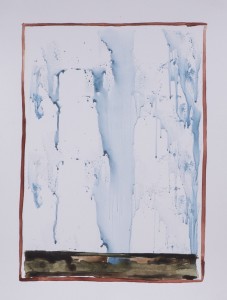 The first image, that of evil, called Abaddon, is dominant and encroaching, seemingly boundless and fearful. The second image is much quieter, gentle but life-giving, boundaried but free. It penetrates the ground rather than taking it over. And it is rimmed by this mysteriously fragile red enclosure. When I made this second image it was after studying some illuminated manuscripts from a book a friend had given me. The first image, as I wrote earlier, took over when I made it, surprised me, troubled me. But it seemed necessary to consider. This second image was planned more carefully, but its making also involved some serendipity. I used a brayer to lay down the veils of blue watercolor, loving the delicate surprise in the markings that resulted, and that were still “in character” with the quiet beauty of good.
The first image, that of evil, called Abaddon, is dominant and encroaching, seemingly boundless and fearful. The second image is much quieter, gentle but life-giving, boundaried but free. It penetrates the ground rather than taking it over. And it is rimmed by this mysteriously fragile red enclosure. When I made this second image it was after studying some illuminated manuscripts from a book a friend had given me. The first image, as I wrote earlier, took over when I made it, surprised me, troubled me. But it seemed necessary to consider. This second image was planned more carefully, but its making also involved some serendipity. I used a brayer to lay down the veils of blue watercolor, loving the delicate surprise in the markings that resulted, and that were still “in character” with the quiet beauty of good.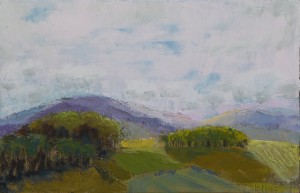 This is where I get to live! My husband and I still revel in such a place to be. He loves the quiet the most. I love the long views. I grew up in flat lands. I was always looking out the windows though, searching, even as a child for something (I knew not what to even call it). I just remember the ache and the longing. And I especially was enchanted by the lines that seemed to point to horizons. Now my horizons are much more enchanting, irregular, changing, suggesting deeper promise.
This is where I get to live! My husband and I still revel in such a place to be. He loves the quiet the most. I love the long views. I grew up in flat lands. I was always looking out the windows though, searching, even as a child for something (I knew not what to even call it). I just remember the ache and the longing. And I especially was enchanted by the lines that seemed to point to horizons. Now my horizons are much more enchanting, irregular, changing, suggesting deeper promise.